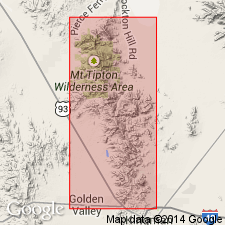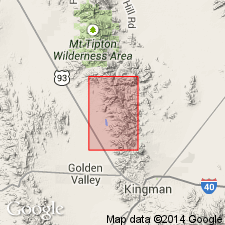
- Usage in publication:
-
- Ithaca Peak porphyry
- Modifications:
-
- Original reference
- Dominant lithology:
-
- Granite porphyry
- AAPG geologic province:
-
- Plateau sedimentary province
Summary:
Pg. 667, fig. 2; 1953, GSA Bull., v. 64, no. 4, p. 403-405, pl. 1. Ithaca Peak porphyry comprises two intrusions of granite porphyry within the Cerbat complex (new). Intrusion in Chloride district is curved steeply dipping sill from 2,000 to 5,000 feet thick, whereas intrusion in Mineral Park district is stock that has roughly circular exposed area 3.5 to 4 miles in diameter. Several thick tongues extend out from southeast side of stock, largest reaching 1.5 miles through Union Basin to Golconda mine. [Age is] Tertiary(?).
Named from imposing crag in Mineral Park district. Both Ithaca Peak and Turquoise Mountain composed of granite. All in Wallapai mining district, Mohave Co., northwestern AZ.
Source: US geologic names lexicon (USGS Bull. 1200, p. 1893).

- Usage in publication:
-
- Ithaca Peak granite*
- Modifications:
-
- Revised
- AAPG geologic province:
-
- Plateau sedimentary province
Summary:
Pg. 130-132, pl. 18. Cited as Ithaca Peak granite and restricted to Mineral Park district. Granite near Chloride tentatively assigned to Precambrian and renamed Chloride granite (new). Main mass of granite stock weathers buff to reddish brown. Fresh rock typically light-gray fine- to medium-grained porphyritic granite. Outlying bodies of granite particularly abundant from Mineral Park south into Stockton and Cerbat camps, some of which grade into granite porphyry, although most are of porphyritic granite. Geographic distribution given.
Source: US geologic names lexicon (USGS Bull. 1200, p. 1893).
For more information, please contact Nancy Stamm, Geologic Names Committee Secretary.
Asterisk (*) indicates published by U.S. Geological Survey authors.
"No current usage" (†) implies that a name has been abandoned or has fallen into disuse. Former usage and, if known, replacement name given in parentheses ( ).
Slash (/) indicates name conflicts with nomenclatural guidelines (CSN, 1933; ACSN, 1961, 1970; NACSN, 1983, 2005, 2021). May be explained within brackets ([ ]).

